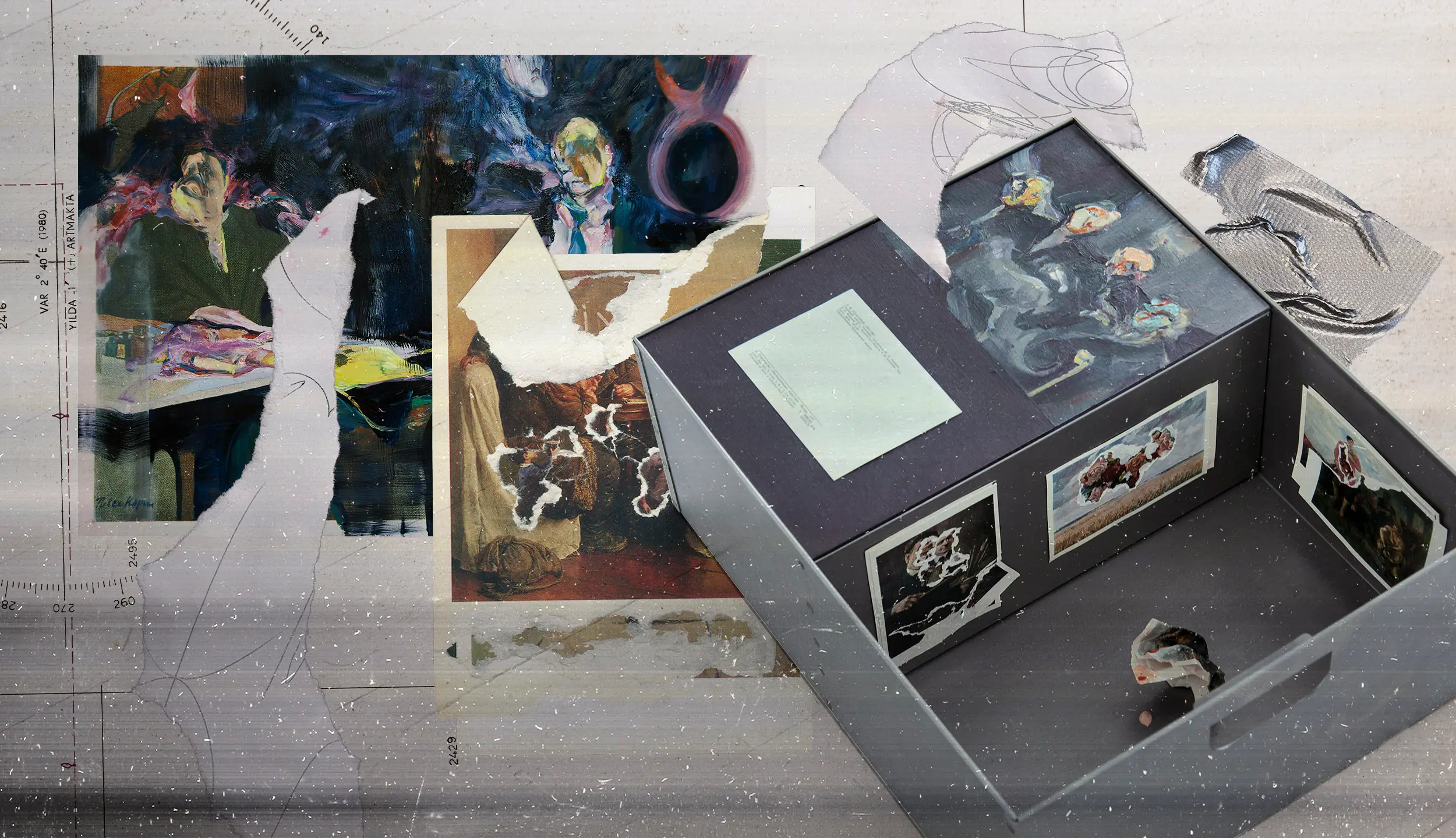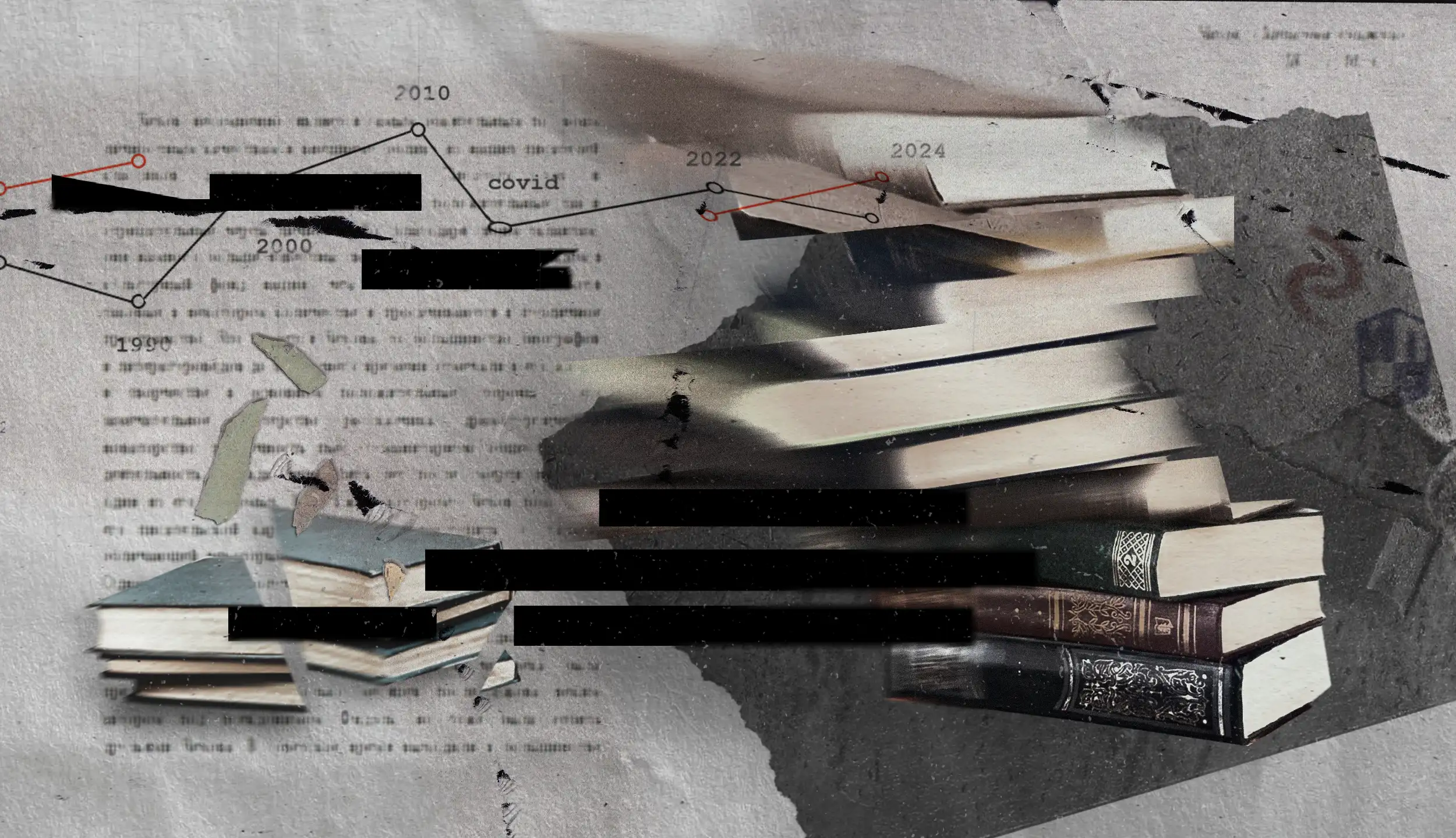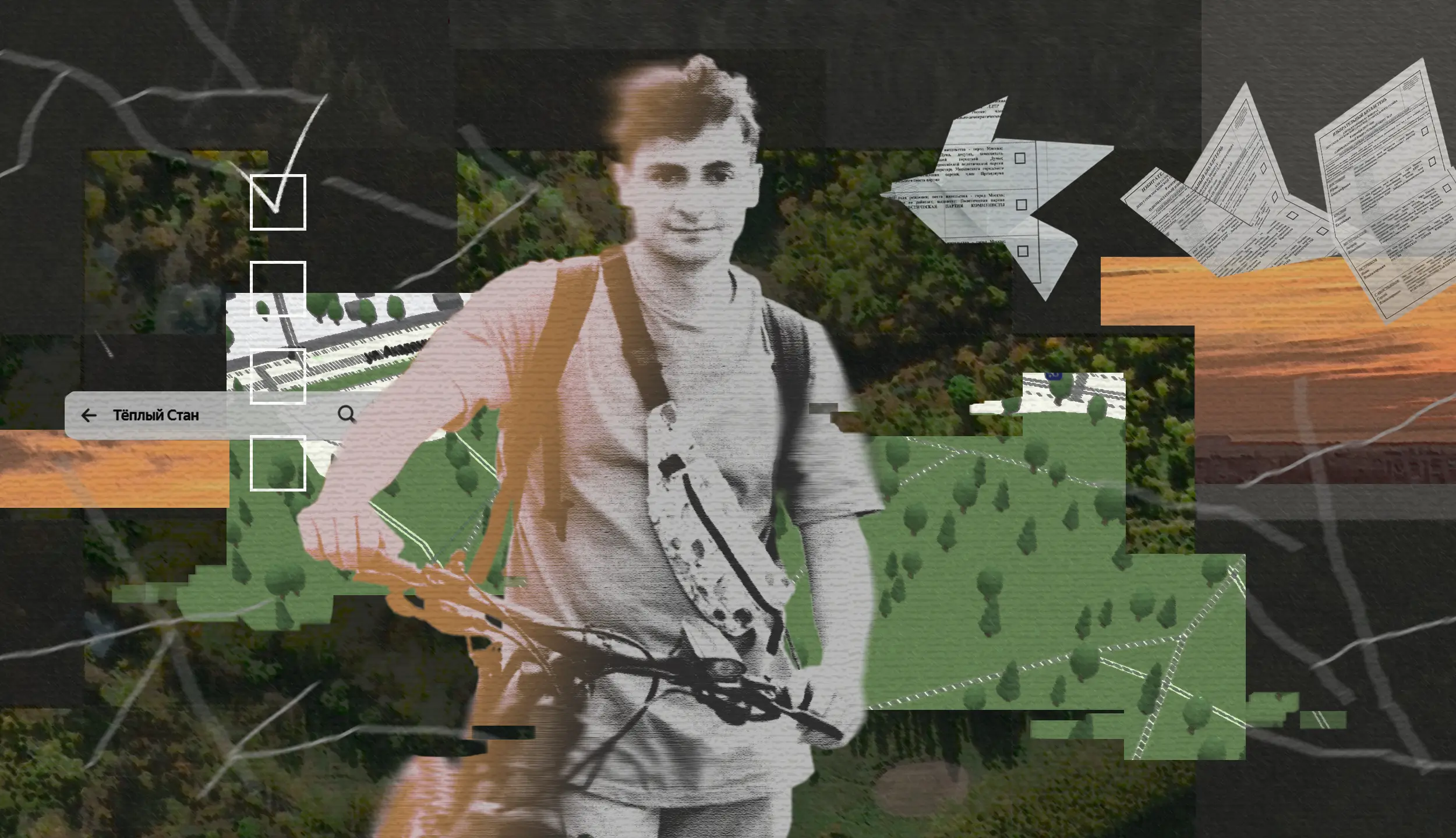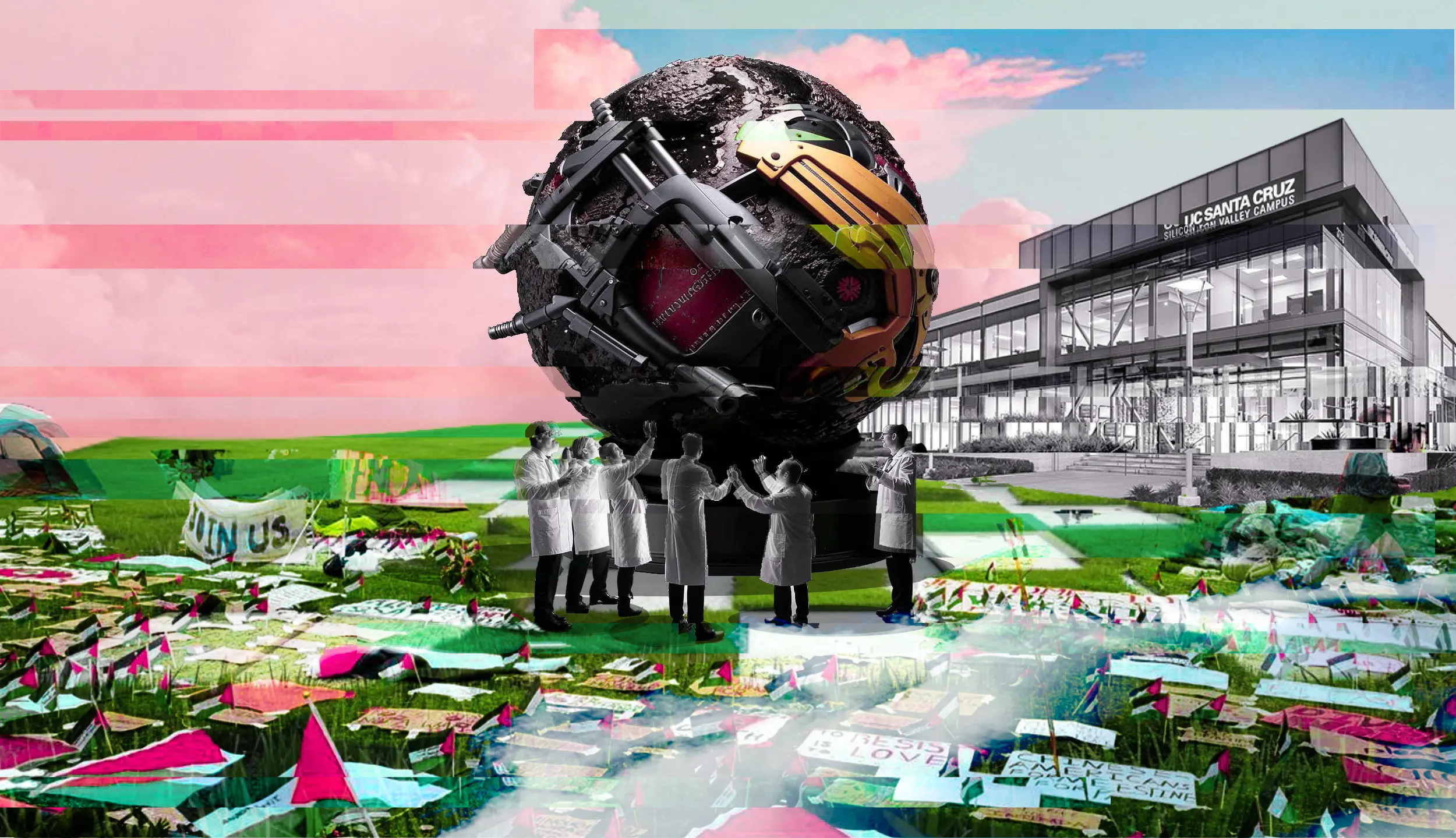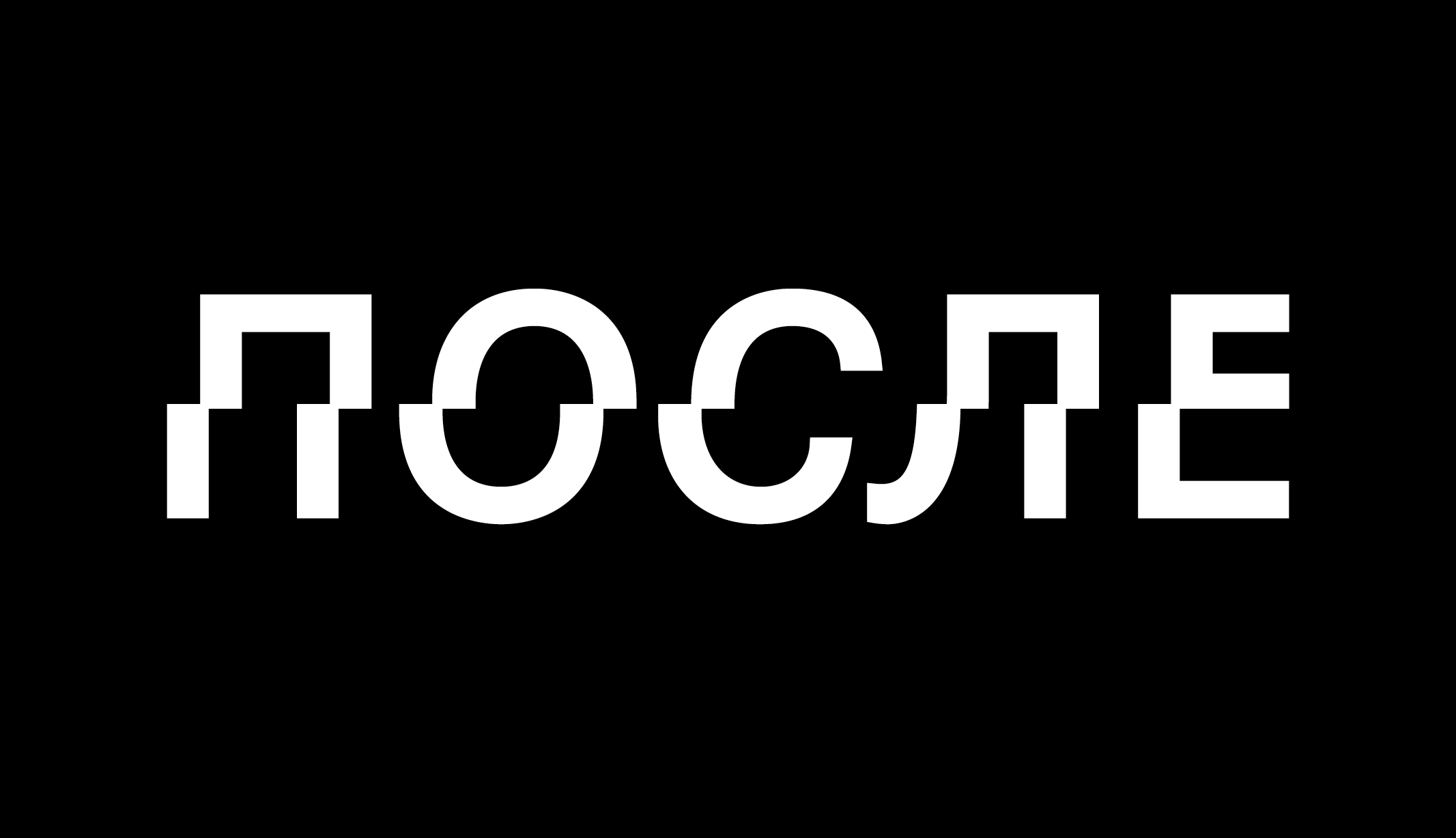— Has your vision of yourself as an artist changed since the Russian invasion of Ukraine?
— The reality I live in has changed completely, because my country has committed an irreparable and terrible crime. And loved ones and relatives are among those targeted. This cannot be undone, forgotten or ignored. The life I had lived is over for good. I had to flee the city I was born in and had lived in my whole life. My works are now seen by people who speak a different language and have a very different visual experience. I have changed as a person. In the past year I experienced more emotional pain than ever. However, as an artist, I am continuing my work in deconstructing the Soviet cultural code, and I am going to keep doing it. But with different tools. It has become evident now that I am lacking decolonial thinking, because I lived my whole life in Moscow, which has always produced the norms and standards. But I never questioned that before. I naturally adopted the hierarchy that equals the metropolitan with the best, which is just complete nonsense. I lack openness. But it will come with time. There is a lot to learn.
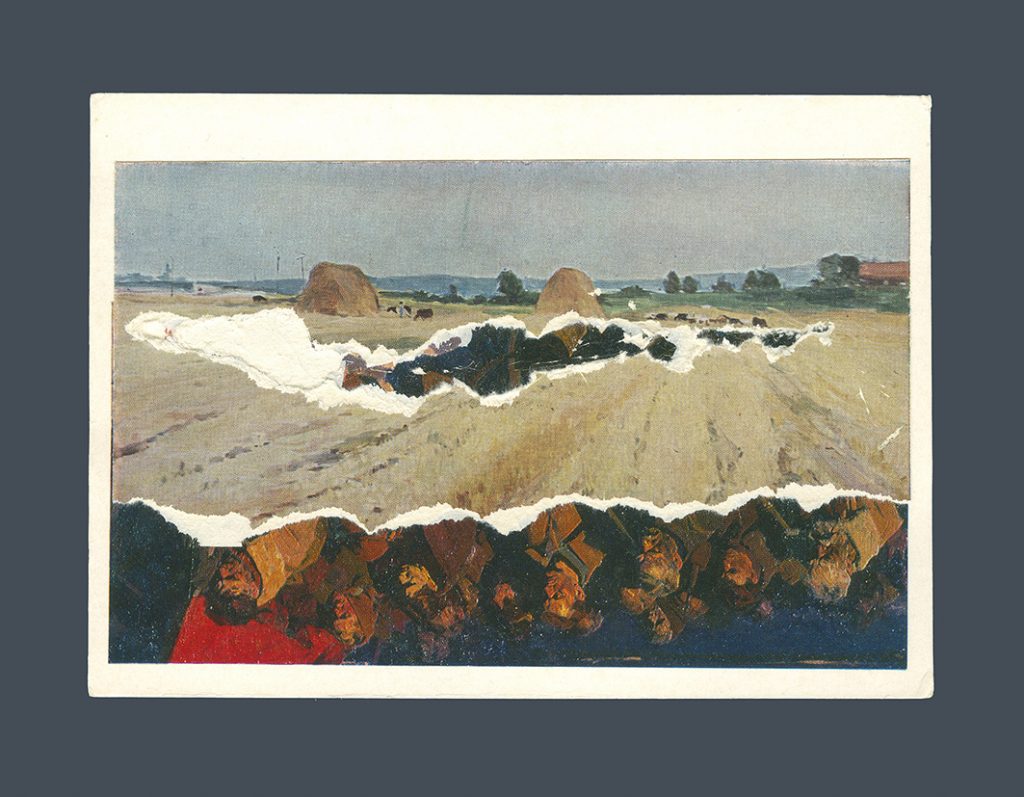
— Artists who speak out against the war are finding themselves facing a dilemma: either to withdraw (because a Russian artist’s work is impossible or because it is inappropriate), or to vehemently search for a new language. What is your solution to the dilemma?
— In the very difficult and traumatic situation that we have found ourselves in, any solution can only be an individual one. I can only speak about my own experience. For the last five years I’ve been systematically deconstructing images of Soviet childhood. I was interested in that aspect of the Stagnation Era under Brezhnev’s rule. But, in the wake of the invasion, I realized I should have worked with a deeper and more toxic layer of the artistic stratum, and that I need to focus on that from now on. That layer is what is nurturing narcissism, denial, aggression and political infantilism to this day. It is, of course, the layer of Stalinist culture. This was how I switched to working with that context and reconsidered my practice accordingly. Nobody will unearth and bury such toxic deposits for us, so the sooner we get to work on them, the better. I keep working because I have an opportunity to do so. I am quite sure this work is not in vain and will yield something in due time.
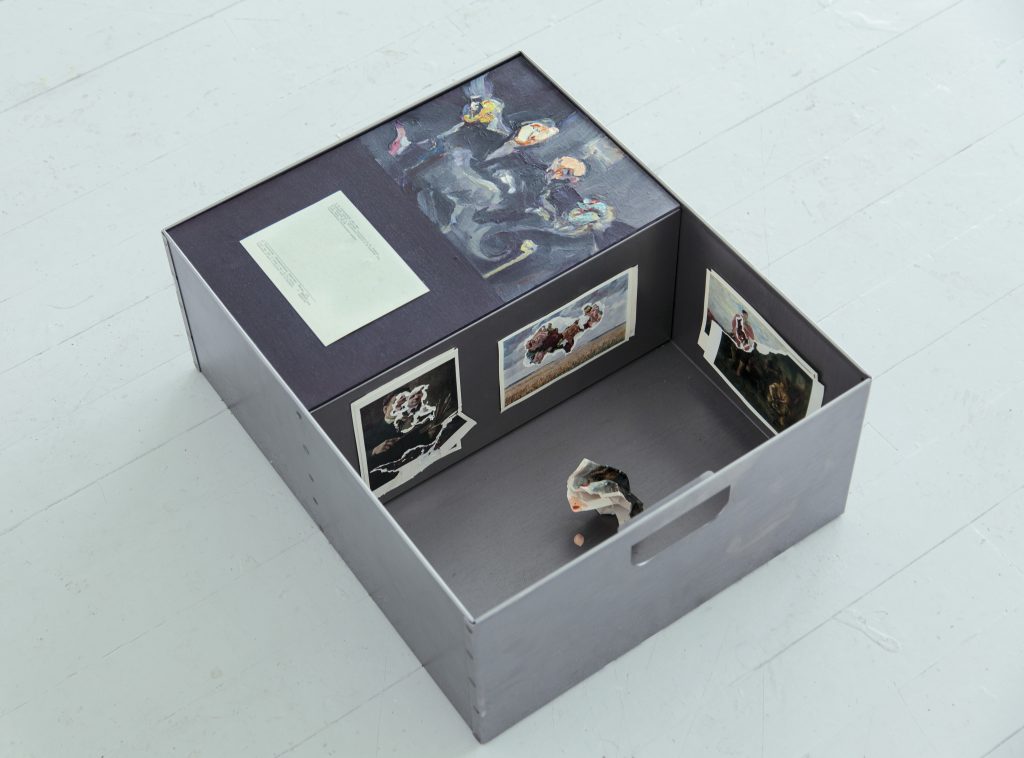
— How did your new work, a series of socialist realist postcards, come about?
— When the war broke out, I started reading a lot about Stalinism and the culture during that period. I was doing research and collecting the necessary material. Since I spent the whole of 2022 on the move changing places, it was physically difficult to work on paintings. And then I thought about postcards. Postcards can fit into any suitcase! I started by just looking through them, spreading them out. Then I noticed recurring motives and compositions and asked myself: what if I combined them and made a sort of hybrid, so that one image would show through another and become something different? All I needed was scissors and glue, and that was how it began. I thought that it would be preparation for a painting, that I would find some compositions in postcards. But it turned out that postcards themselves have their unique materiality and an interesting visual potential.
The working title of my work is “The Case”: I want to exhibit the postcards in steel cases. But the work is undergoing a new development now: I will try to use postcards as a kind of primer for painting.
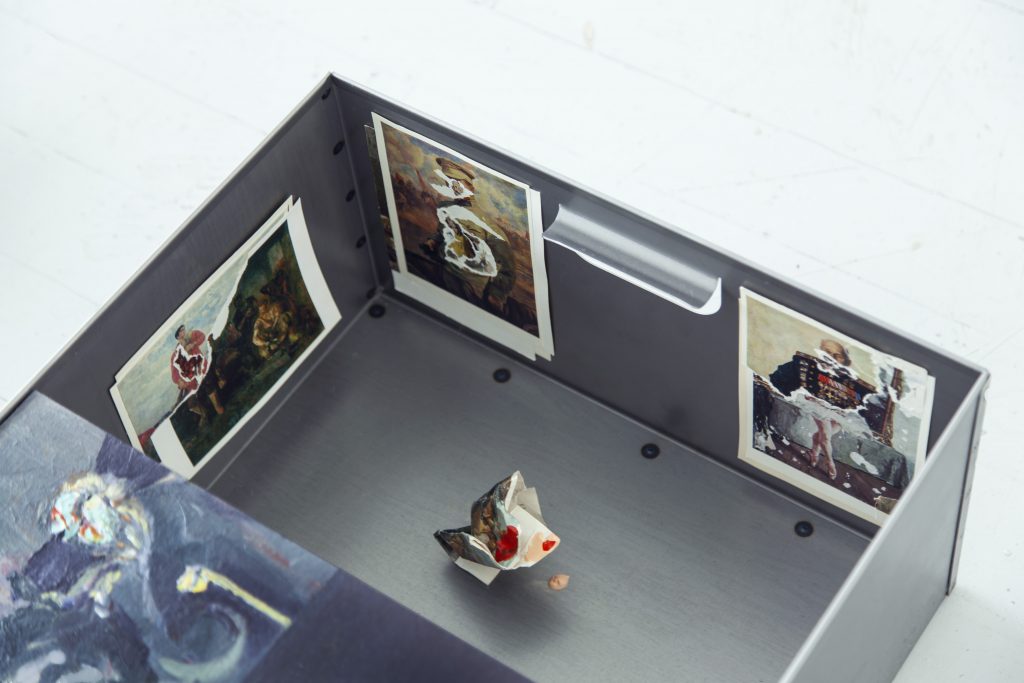
— What is your understanding of Socialist Realism? In literature and in painting alike it was very heterogeneous, with each artist having their own artistic background. It is difficult, for instance, to compare Deineka’s paintings with countless portraits of Stalin and Voroshilov (like Gerasimov’s “Stalin and Voroshilov in the Kremlin”).
— The phrase belongs to Igor Golomshtok, I think, but I first heard it from Nadia Plungian. “Socialist Realism is flattery to the leaders in the visual form.” I find the definition very accurate, although it’s not just about flattery. In art and literature alike, Socialist Realism is a system of a symbolic production of a Soviet identity. Like any national identity, it was grounded in an emotional myth about Soviet people themselves and, of course, the Soviet government. The experience of totalitarianism was defining for everyone, including the ruling elites, so the elites sought to control how people represented themselves; they wanted to shape the image of themselves, and applied harsh sanctions to those who questioned this image. They needed the control in order to have the identity embedded in, and to provide support to, the vertical of power that existed at the time. Had there been more opportunities for Soviet people to shape their self-image in a more spontaneous way, they would be in a position to question the regime’s legitimacy much earlier than they actually did. Hence the necessity of Socialist Realism in cinema and literature: what interests me most is precisely the need for Socialist Realism by the authorities, Socialist Realism as a framework for the authorities themselves and for forming a Soviet identity.
I primarily focus on paintings created during late Stalinism after the Second World War that were awarded with Stalin Prizes or purchased by art museums. According to [the historian] Evgeny Dobrenko, that was the moment when a Soviet identity had taken shape and developed into a national myth that had its complexes and projections. If the myth was created by means of art, then it is possible to dismantle it by means of art.
There were, of course, many talented people both in the Artists’ Union and the Writers’ Union. I enjoy many works by Deineka, especially from the 1920s and 30s. But we need to be honest: there were limits to Deineka’s expression, and any kind of direct criticism of Soviet realities would be impossible in his paintings. Spontaneity was certainly impossible, too, as was any deviation from the artistic conventions set by the official directives of the Party.
— Do you think that a possible strategy is reappropriating Socialist Realism, taking it away from Stalin’s regime and liberating it from its task of social construction and myth production?
— I don’t quite understand what reappropriation could mean in this context. For instance, LGBT activists in the US in the 1980s did reappropriate the word “queer”, transforming it from a derogatory label into a word that sounds neutral, no more offensive than the word “punk,” for instance. In that case, it was a matter of moving something marginalized and displaced into the cultural mainstream. But Socialist Realism is already a part of Russian cultural mainstream: the paintings are exhibited in the major museums that are supported by the Russian state. Films like “Officers” are routinely broadcast on TV. Large public universities where artists are taught have not been reformed, and, although those schools don’t seem to have direct censorship (at the moment, at least), they haven’t made a substantial revision of their approaches to teaching or the figurative canon, either. Moreover, the state is also trying to “revive” Socialist Realism with films like “T-34” and Panfilov’s “28 Men.” Socialist Realism is far from being marginalized, it is foundational for Soviet and post-Soviet identity, it is within ourselves. It deals with important themes: the Second World War, the transformation of a traditional society into a modern one, the October revolution, all of which have great significance to us. The problem is that it doesn’t allow a discussion about inequality, horrors of war, the state terror against its own people, violence in a broad sense of the word. Narcissism and self-censorship are embedded in Socialist Realism, as well as the notion that the state can prescribe to artists and people in general what to think and feel. These are not the safe, naïve, colorful pictures they want to appear to be. Well, this is the cultural landscape that we have, and it has this “radioactive background.” How to get rid of this background? We need to revisit our cultural heritage looking at it through a critical lens, in order to call things for what they are, at the very least. This is actually also the answer to the question whether Russian or Soviet (or any other) culture needs to be canceled: no, there is no need to destroy or cancel it, but we must revise and resee it. If that is what you mean by “reappropriation”, then I’m willing to agree.
Here’s an example. In 1958, Terence White’s book The Once and Future King was published, a bestselling novel based on the story of King Arthur. It was about the British national myth, a British “Socialist Realism” of sorts, if you will: a story about real men battling in shiny armor. Thirty years later, Marion Bradley wrote The Mists of Avalon, also a novel about King Arthur and his knights, but from the perspective of the female characters. All the same events, but seen through women’s eyes: the result was a feminist novel that redefined understanding of how a story about knights could be told. Imagine what it would be like if The Irony of Fate (1976) was remade from the perspective of female characters, such as the protagonist’s mother? It could be hilarious and fun. How about Seventeen Moments of Spring (1973) from Kate’s perspective? Russians would be able to see themselves in an entirely different light.
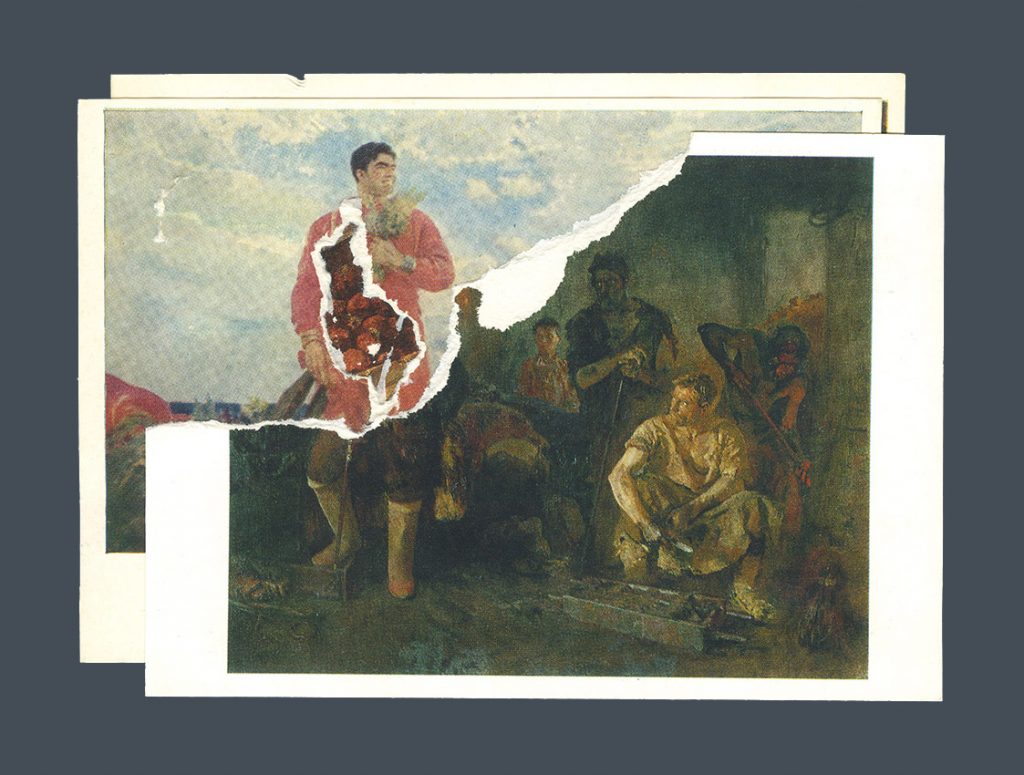
— Does the fact that postcards with Socialist paintings had other functions besides the propaganda — like postage, collecting, etc. — have any relevance to your work?
— Postcards are not interesting to me in themselves, but only as a mechanical mass reproduction of painting, and painting interests me above all. Which is why I do keep in mind the functions you mentioned, but at this point it is a potential of the material I am working with, which I may or may not use as I proceed with my work. I can say that I have recently stumbled upon a rare readymade: a whole album with Socialist Realist postcards collected by someone long ago. I would love to do some serious work with this object.
— What does it mean to deconstruct a postcard? Or, in other words, what is the method, how does it work and to what end?
— It is, for me, an aggressive gesture that a child might make while playing. It’s like when you are given something dull and you find a way to transform the dull thing into something unexpected. I have a theory that narcissism, which is inherent in totalitarianism, is best undone by free play. I make layers out of postcards by gluing them onto each other; then I scratch them through to make holes and fragments — resulting in new compositions that now have an entirely different message.
— Against the backdrop of Russian military aggression, many things from the distant and the near past, not to mention the present, have revealed some new facets. Have you discovered anything in these paintings or the postcards themselves since you started working with them?
— Absolutely. It was the first time ever that I really pondered over this art, without brushing it off or distancing from it, and I’ve kept seeing it this way since. I had made conscious efforts to ignore Socialist Realist art, because it always made me cringe. And now two things struck me. First, I discovered how many works portrayed military men: there are paintings with soldiers in combat and at rest, portraits of marshals, an abundance of tanks and other weapons. There is a sense of obsession with war, a fixation. Second, these works are stunningly narcissistic. In the cultural, not individual sense: kind of a magical mirror, on the one hand, showing you how great it all is; and, on the other hand, these compositions are very didactic. Either you are a happy person, a hero, or a cartoonish “bad guy” who just needs to be reformed. These paintings define you and themselves that way. They quite cleverly conceal the fact that other images and other versions of self-determination are possible, which can emerge spontaneously, without instructions from above about how you should live and, most importantly, who you should be.

— In 2012 you made a striking art-project devoted to the women of Narodnaya Volya—[the revolutionary organization The People’s Will of the late nineteenth century]–, whose portraits could be seen on walls and fences around the city. That work combined street art with activism. Now, on the other hand, you are dealing with postcards, which is something completely different, almost private and decorative. Is it because of the historical circumstances?
— Yes, that was a good, important project. It was also my first project that I did intuitively, by instinct, with no previous experience or education. For many years now, I have been working in a very different way, critically reinterpreting Soviet art. I can’t agree that postcards are something private and decorative. These aren’t just any postcards after all, but postcards that demonstrate official art, that is, they are a way of bringing this art to your home and making it a part of your everyday environment. Besides, postcards aren’t private letters: they were often dispatched without an envelope and everyone could read the message. Postcards are also a part of a symbolic exchange between people who would give them to each other, exchange them and display them in albums. So the position of postcards is rather on the border between private and public, official, ritual; at the gap where identity emerges and functions. I deal with a totalitarian identity that must be reconsidered and redefined, lest the catastrophe of violence perpetuates itself. But I don’t want to reconsider it in the same vein as Dubosarsky and Vinogradov in the 1990s or Komar and Melamid in the late Soviet period, although those were great and timely works. But now’s not the time for postirony as a critical method.
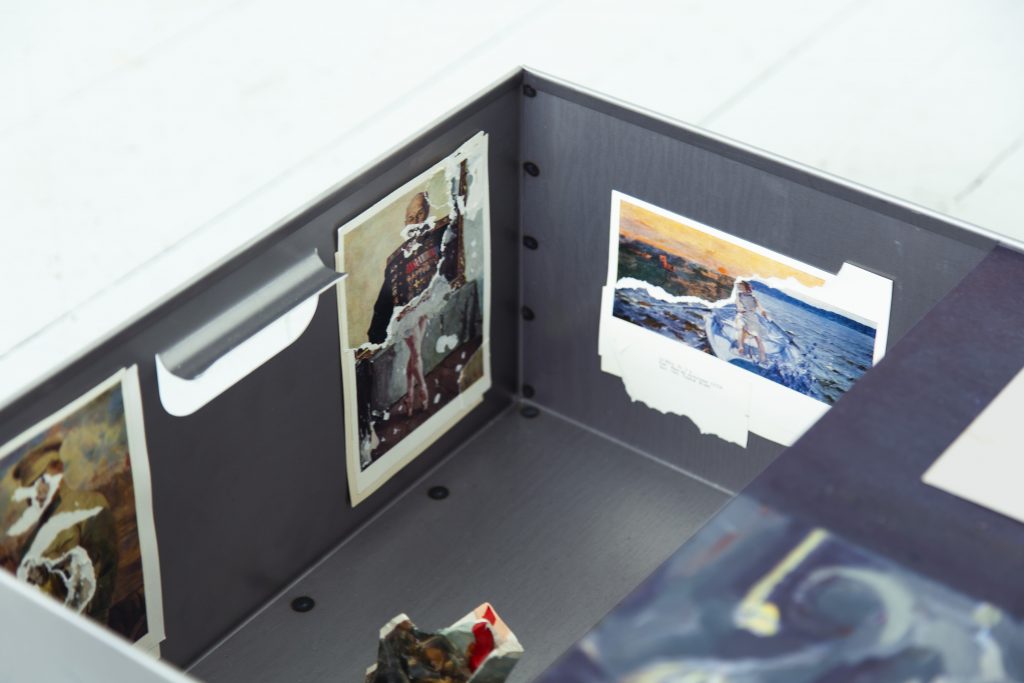
This publication was supported by Сhto delat e.V.

